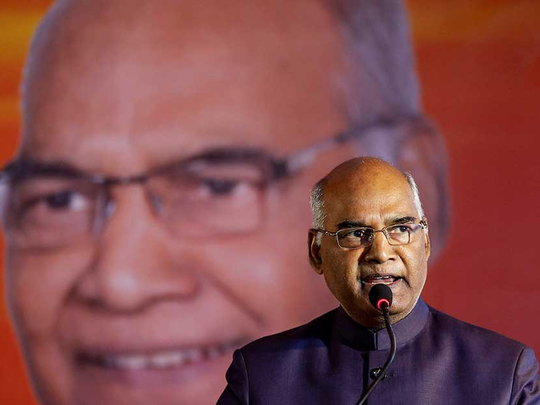
Only the naive will believe that the elevation of a Dalit (lower caste), Ramnath Kovind, as the President of India is of seminal importance either for the community or for the party that chose him.
For one, India’s ruling Bharatiya Janata Party’s (BJP) nominee is not the first Dalit to adorn the post. K.R. Narayanan was there before him with the Congress’s support. For another, these elevations no longer make the kind of impact on the electoral scene that is expected by the sponsors of such candidates. Just as APJ Abdul Kalam’s selection by the BJP has not made the Muslims come flocking to its door, the choice of Kovind will be seen for what it really is — a cynical exercise that is more indicative of political calculations than of genuine interest in Dalit welfare.
Had the opposite been true, then the Congress would have been expected to gain from the choice of Narayanan. But there has been no such evidence. Similarly, the BJP is only hoping against hope that Kovind will make Dalits gather under its banners in large numbers.
What has to be recognised in this context is the change that is taking place in the attitude of the Dalits, especially the younger generation, where the focus is shifting from the traditional politicians in the age bracket of senior citizens to articulate and ambitious youngsters. To them, Kovind, like the Bahujan Samaj Party (BSP) leader Mayawati, belongs to the past. Kovind’s added disadvantage is his Rashtriya Swayamsevak Sangh (RSS) background, since Dalits in general, and especially young leaders like Chandrashekhar Azad “Ravan” and Jignesh Mevani, are vociferous critics of Manu Smriti, the ancient textbook of Hindu orthodoxy that is highly regarded by the RSS. The RSS is also known to be against reservations for Dalits. It was the reiteration of this position by RSS chief Mohan Bhagwat that was believed to be partly responsible for the BJP’s defeat in Bihar in 2016.
To the likes of “Ravan”, the hero is someone like Rohith Vemula, the bright young scholar of Hyderabad Central University, who committed suicide following a confrontation with the Akhil Bharatiya Vidyarthi Parishad (ABVP), the BJP’s student wing. Considering that one of the Union ministers, Smriti Irani, who wrote to the vice-chancellor about the presence of “anti-national” elements in the university, is now back as Information and Broadcasting Minister, the BJP may continue to find it difficult to reach out to Dalits, notwithstanding Kovind’s ascent to the highest constitutional position in the land.
It is undeniable that the BJP attracted considerable support from Dalits in the last general election because they were as impressed by Narendra Modi’s promise of economic development as the rest of the new generation. In the recent Uttar Pradesh elections, too, the BJP won 69 of the 85 reserved seats. Evidently, the Modi “magic” was still working.
But a carefully-crafted tactic of weaning away the non-Jatav Dalits from the BSP — and also the non-Yadav backward castes from the Samajwadi Party — played a key role in ensuring the BJP’s success.
Kovind is a non-Jatav, a Kori — who are traditionally weavers — unlike his defeated challenger, Meira Kumar, who is a Jatav-Chamar — associated with tanning or the skinning of animal carcasses for the leather industry. It was such an act of skinning that had led to a group of Dalits being lynched by gau rakshaks or cow vigilantes in Una, in Gujarat, last year. It was that incident, along with the clashes between Dalits and Thakurs in Saharanpur in Uttar Pradesh recently, that are believed to have persuaded the BJP to choose Kovind in order to mollify Dalits.
But whether the BJP will succeed in doing so will depend on the pronouncements of the new president. Although these will undoubtedly be vetted by the government, they may provide occasional glimpses of his thinking, especially whether he continues to adhere to the RSS line, where the social scene is concerned, or has become a votary of the prime minister’s economic agenda.
The choice of Kovind can be regarded as the BJP’s last throw of the dice before the next general elections in 2019, to bring into its fold a community which, like the Muslims, has not always been the party’s supporters. Having already given up all hope for gaining Muslim support — as Union Law Minister Ravi Shankar Prasad recently conceded — the BJP evidently wants to counter the signs of alienation that it sees in the Dalits in the aftermath of the suicide in Hyderabad, the lynching in Una and the caste riots in Saharanpur.
Among its latest efforts in winning hearts and minds are the stern messages against cow vigilantes, whose murderous attacks have also been directed against Dalits, although Muslims have been the main victims of such attacks.
Since the present dispensation has succeeded to a considerable extent in stopping the ghar wapsi (homecoming) and love jihad campaigns of the Hindutva hardliners, it may be able to rein in the cow vigilantes as well.
But these antics of the saffron hawks are no more than symptoms that can be suppressed for a while. The Sangh Parivar’s real ailment, however, is a Brahmin-Bania disdain for the “untouchables”, which is too deeply ingrained to be easily removed by an act of tokenism.
— IANS
Amulya Ganguli is a political analyst.










